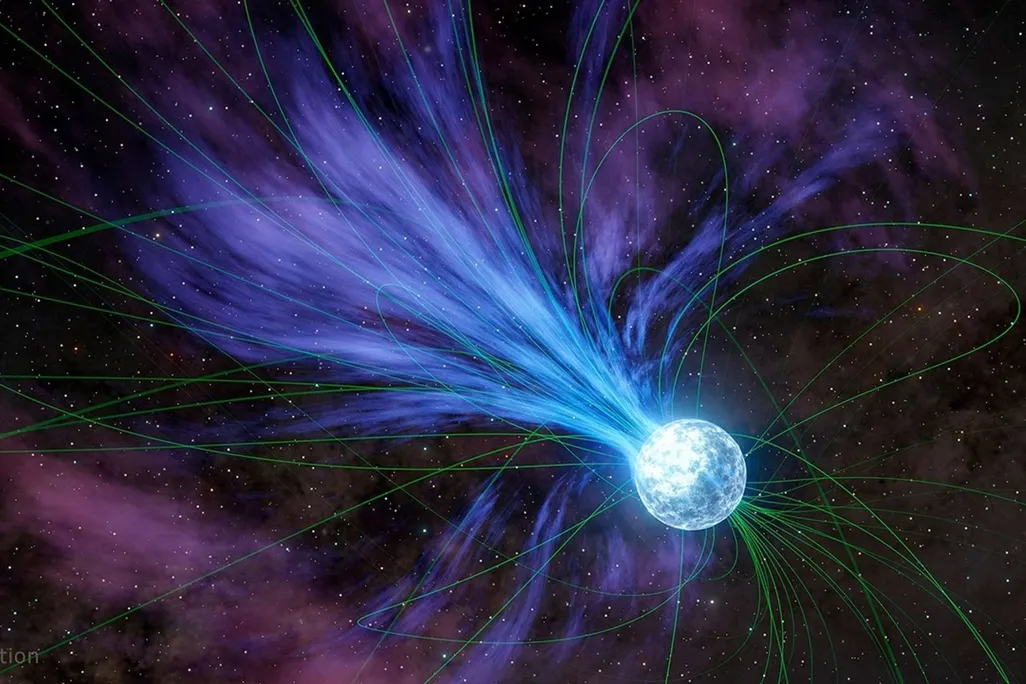WWW.SMITHSONIANMAG.COM
Astrophysicists Track Down the Mysterious Cosmic Origins of Gold and Other Heavy Metals in Our Galaxy
Astrophysicists Track Down the Mysterious Cosmic Origins of Gold and Other Heavy Metals in Our Galaxy
Researchers suggest powerful bursts from magnetars—collapsed stars with strong magnetic fields—may have contributed up to 10 percent of all elements heavier than iron in the Milky Way
An artistic rendering of a magnetar—or highly magnetized neutron star—losing material into space. The magnetic field lines, shown in green, direct the movement of charged material.
NASA / JPL-Caltech
Industries such as technology, medicine and agriculture rely on naturally dense elements known as heavy metals. But despite these materials’ importance in our lives, their cosmic origins largely remain a mystery. While iron is known to form in the fiery cores of stars, astrophysicists are still chasing down the sources of heavier elements, such as gold.
“It’s a pretty fundamental question in terms of the origin of complex matter in the universe,” Anirudh Patel, a theoretical astrophysicist at Columbia University, says in a NASA statement. “It’s a fun puzzle that hasn’t actually been solved.”
Now, in a study published last week in The Astrophysical Journal Letters, Patel and his colleagues suggest a possible source for up to 10 percent of all elements heavier than iron in our galaxy: giant flares launched by magnetars.
Magnetars are neutron stars—the highly dense, collapsed cores of exploded stars—with powerful magnetic fields. Sometimes, the motion of the magnetar’s interior leads pressure to build up on its surface, which ultimately unleashes energy in a “starquake.” These chaotic events can include strong and rare bursts of radiation called magnetar giant flares. Scientists have documented only three magnetar giant flares in our galaxy and its vicinity, and they’ve seen just seven beyond it.
A rupture in the crust of a magnetized neutron star—caused when pressure builds up and leads to a "starquake"—can emit powerful blasts of material known as magnetar giant flares.
NASA’s Goddard Space Flight Center / S. Wiessinger
As a flare’s ejected material cools and expands, the protons and neutrons in atoms can become rearranged, creating heavy metals. Elements are determined by their number of protons. But when atoms take on extra neutrons, they might become unstable and convert those neutrons into protons in a process called nuclear decay, which changes the identity of the element. Around neutron stars, atoms can turn into much heavier elements by accumulating many neutrons at once and decaying a series of times.
“If you think about the basic ingredients of what everything’s made of, it’s just neutrons, protons, electrons,” Patel, who is the lead author of the study, tells the Washington Post’s Kasha Patel. “The question is how does nature forge these basic building blocks into the complex matter that we see all around us.”
Researchers already had one potential explanation for heavy elements: collisions between neutron stars. In 2017, researchers found these mergers could create heavy elements such as gold and platinum. But these alone can’t account for all the heavy elements present in our galaxy and universe. “The trouble with neutron star mergers is that they occur relatively late in the history of our galaxy,” Patel tells Science’s Jenna Ahart. So, any heavy elements formed before that time would have come from a different source.
Some of the study’s authors had previously suggested that magnetar giant flares could be the mysterious other origin. But they needed direct evidence.
For the new paper, the team investigated records of a massive magnetar giant flare that was observed in 2004. They predicted the potential gamma-ray signal that would have been emitted if elements from the flare had decayed into heavy metals.
Then, when analyzing the gamma-ray data from NASA and the European Space Agency (ESA), they came across a previously unexplained smaller signal. The researchers were surprised to see that the smaller gamma-ray signal matched their predictions of what a heavy-element-creating magnetar giant flare would look like.
“When initially building our model and making our predictions back in December 2024, none of us knew the signal was already in the data. And none of us could have imagined that our theoretical models would fit the data so well,” says Patel to CNN’s Ashley Strickland.
“This is a very exciting development,” says Hsin-Yu Chen, an astrophysicist at the University of Texas at Austin who was not involved in the research, to the Washington Post. “It shows new observational evidence for another way heavy elements can form in the universe.”
Moving forward, researchers will continue investigating archival data for past magnetar giant flares—and prepare for the next one.
“Perhaps the most exciting possibility from this paper is that for the next magnetar giant flare, we could detect individual elements,” says Charles Horowitz, a physicist at Indiana University Bloomington who also did not participate in the research, to Science.
Get the latest stories in your inbox every weekday.
